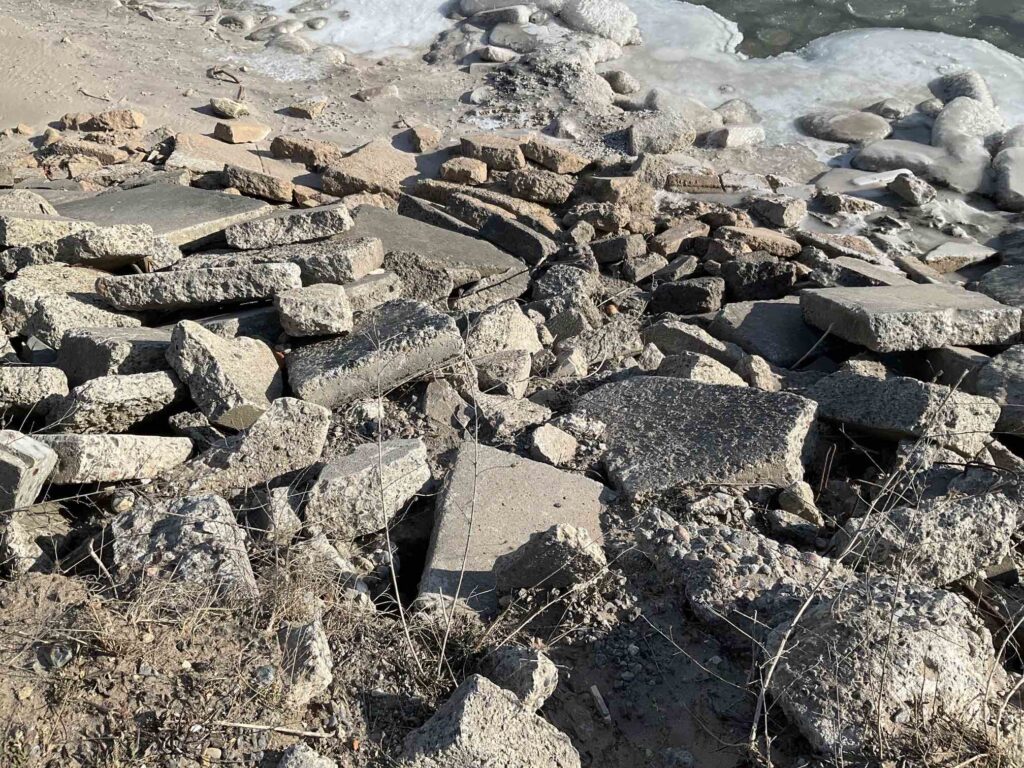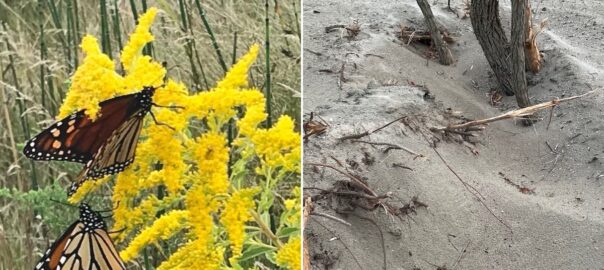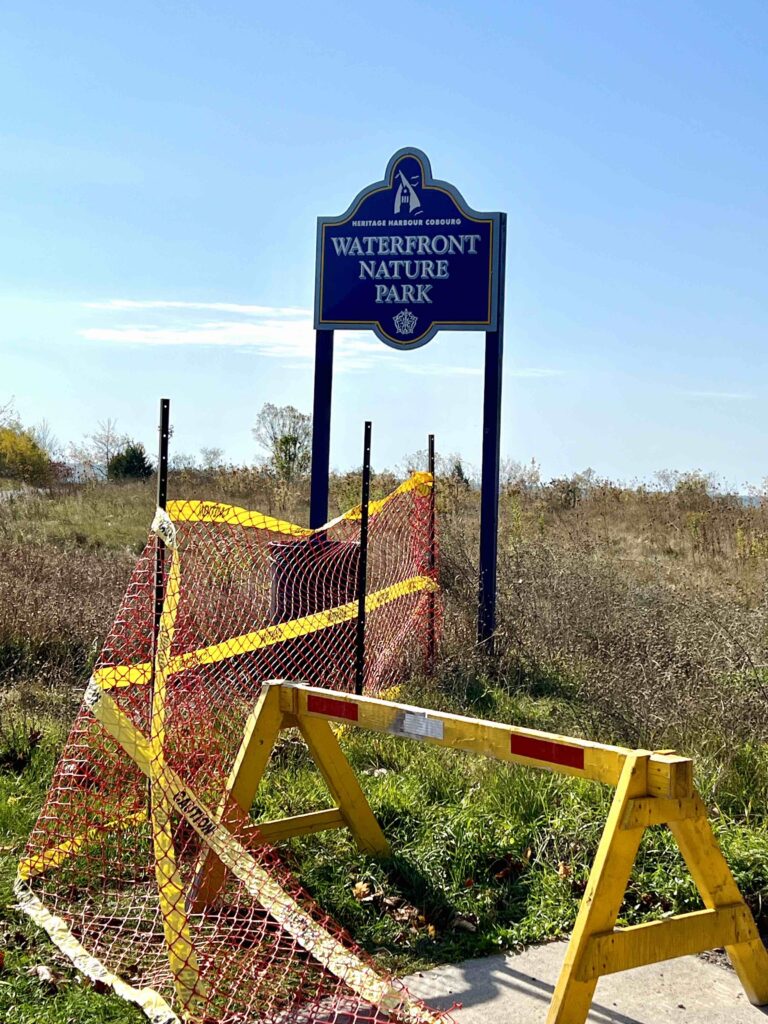Many people in the community were upset about the removal of the sand willows on the West Headland. They were upset about the dredging and angry that no one knew about this in advance.
Then people (myself included) were stunned to learn that the dredged area has somehow been excluded from the Waterfront Nature Park, which even Council did not know about.
When Council voted to create the Nature Park, they thought this area was included in it.

After mulling this over, I thought I should give people a heads-up on the plans for the area because much worse is yet to come and the public is apparently not going to be shown an action plan with a timeline for what is planned.
The intent of this memo, however, is not to criticize forth-coming action but to focus public attention and the attention of Council on how we can salvage the West Headland and re-naturalize it after the damage is done.
There is light at the end of the tunnel and the public can help to ensure that this light gets to shine.
As we know, the Town needs to undertake major repair to the East Pier, the inner harbour, the Centre Pier, and the West Breakwater. It appears that contrary to the original schedule, the West Breakwater is to be tackled first (work was originally scheduled for 2024).
Some of the work will be done from the water by barge, but the large number of huge rocks (riprap) weighing tons apiece is to be trucked out over the headland, much of which is in the Nature Park. Sadly, this cannot be avoided.
Obviously, the West Headland will be severely damaged and further compacted by the time the breakwater repair is finished. All we can do is prevail upon Director Geerts to use his influence to minimize the damage.
Since the damage to the Headland is unavoidable, it seems to me that we should focus our attention and the attention of Council on ensuring that proper restoration and rehabilitation take place after work on the West Breakwater is completed.
An idea that the Council has already endorsed when approving the creation of the Nature Park.
The West Headland is a disappointing eyesore after the spread of soil contaminated with glass and plastic from end to end (photo 1), grading and denuding (photo 2), unsuccessful attempts to seed it with lawn turf seed, the dumping of broken cement and rebar all over the southern end (photo 3), and roads punched down to the beach by sand removal trucks.



It was not always this way and used to be a pleasant old field with flowers.

How can it be re-naturalized and made better than it has ever been? How can we make it into a beautiful place we can all be proud of?
The now defunct Parks and Recreation Committee (PRAC) made many suggestions on how to improve the area that have not yet been carried out (though they were endorsed by Council).
Among these the following should be revisited and kept foremost in mind for the restoration of the West Headland:
Soil Study: The Town should conduct an environmental soil study of the composition of the West Headland before finalizing the rehabilitation process. In particular, this study should include analysis of core sampling by augur.
Land/Soil Rehabilitation: Once results of the environmental soil study are received, plans to rehabilitate the land and soil should be undertaken.
In the Natural Heritage Study in the Waterfront User Needs Assessment (May 2018), many specific recommendations were made: “Clean up headland to remove concrete debris and miscellaneous waste” (p. 39).
Note also that BEA (Beacon Natural Heritage Stewardship Report, December 2021) 6.2.6 recommends Shoreline Clean-Up, “specifically the western pier [the West Headland] and breakwall” (p. 15).
BRI (Plan B Natural Heritage by Brad Bricker, an Appendix to Waterfront User Needs Assessment (May 2018; p. 4) explains that “The west headland exhibits a long history of disturbance.
Various types of rock and debris have been deposited in this area to reinforce it and to help to protect the harbour. The lack of native topsoil in the headland constrains the establishment of plants.
From an aesthetic standpoint, this area of the waterfront would benefit from clean-up and restoration, and on-going maintenance.”
Invasive Species: Invasive species (e.g., European Reed, Dog-strangling Vine, Wild parsnip) should be removed.
Replanting: The Natural Heritage Report in the Waterfront User Needs Assessment recommends: “Augment selective portions of the headland with sufficient topsoil to facilitate plant establishment and restoration plantings. Locally indigenous plant species should be used to supplement the existing vegetation. Include thicket-forming shrubs (red-osier dogwood, willow, bramble, serviceberry, viburnum) to provide additional cover/food for birds and other wildlife species.” “Incorporate additional riprap/armour stone at south end of headland to create small coves or embayments for shorebirds and waterfowl.”
Headland Walkway: The Town should construct a meandering accessible pedestrian walkway along the Headland, complete with occasional benches, composed of limestone crush wide enough to accommodate access by maintenance vehicles.
Pavilion: The Town should construct a pavilion, comprised of a basic hard floor, waist-high walls, open sides, and a cedar-shake roof.
This pavilion/overlook should be located at the end of the Headland walkway, just before the West Breakwall. [The little pavilion in the Bond Head Waterfront Park at the south end of Newcastle is a nice example of what is possible].
In the lamentable absence of any official channel through which members of the public can have a say in these matters, members of the public should be considering the best ways to keep these existing ideas in the mind of Council and Director Geerts and the Department of Public Works.
The PRAC recommendations also included the idea of community partnership and the encouraging of the participation of the general public in the stewardship of the area. It was felt that people should be given some say and a chance to help.
Willingness has already been demonstrated; witness the recent tree plantings on the headland. The public’s interest in the area has been clear ever since The West Harbour Waterfront Development Plan – March 1995, and the many studies and plans of the last thirty years (yes, this has been going on for over thirty years) have underscored this.
In my memo of December 4, 2024, on “The Waterfront Nature Park and its Immediate Environs,” I floated the idea of an ad hoc committee that would include members of the public, a member or members of Council, Director Geerts and staff to discuss plans for the area (including the threatened and declining West Beach) and how best to manage nature in light of the up-coming harbour repairs.
Is this too much to ask? Surely the Town is accountable to the public.
Richard Pope























